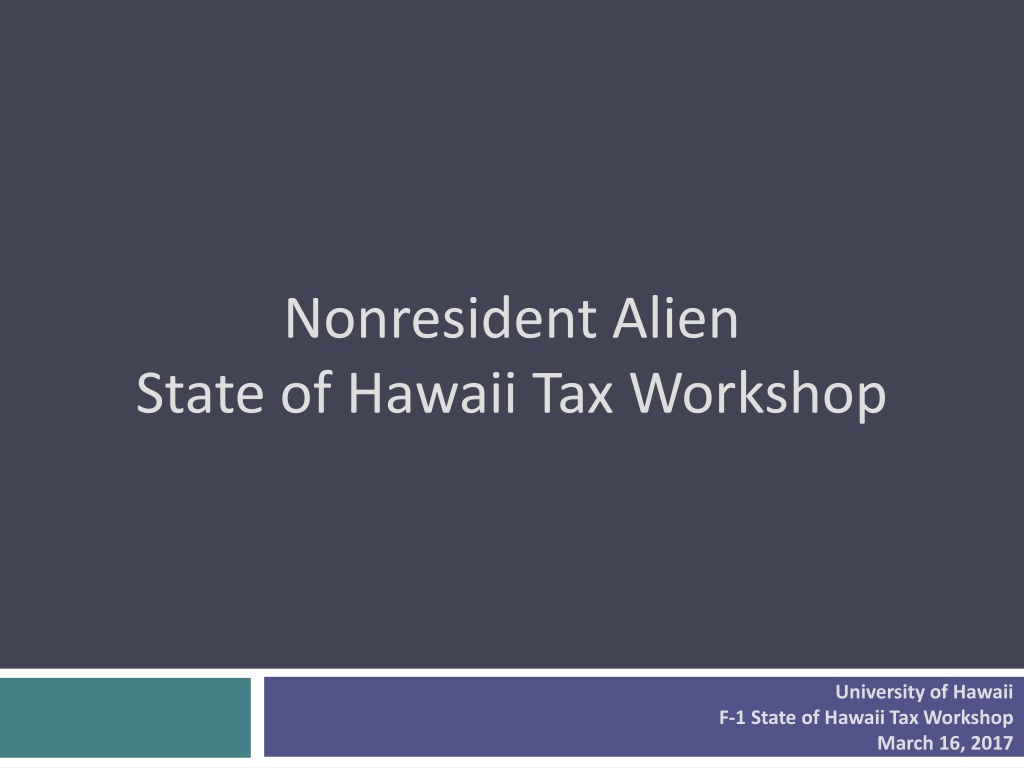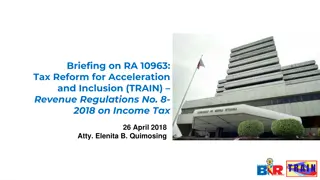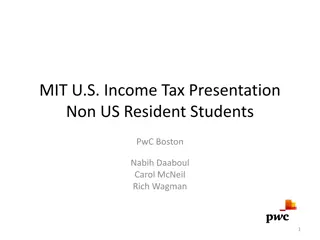Understanding Hawaii State Tax Workshop for Nonresident Aliens
This overview delves into the nuances of Hawaii state tax regulations, focusing on key differences and similarities with federal tax laws. It covers residency classifications, filing requirements, domicile establishment, and the criteria for Hawaii residents for tax purposes. Whether you are a domiciliary or non-domiciliary resident, understanding these details is crucial for complying with Hawaii tax regulations.
Download Presentation

Please find below an Image/Link to download the presentation.
The content on the website is provided AS IS for your information and personal use only. It may not be sold, licensed, or shared on other websites without obtaining consent from the author. Download presentation by click this link. If you encounter any issues during the download, it is possible that the publisher has removed the file from their server.
E N D
Presentation Transcript
Nonresident Alien State of Hawaii Tax Workshop University of Hawaii F-1 State of Hawaii Tax Workshop March 16, 2017
Major Differences: Federal & Hawaii Federal Hawaii Tax treaties None Green card test None Substantial Presence Test 200-day test (depends)
Similarities: Federal & Hawaii Federal Hawaii Filing status Same Dependency exemption Same Resident tax on worldwide income Same o Nonresident aliens pay tax on Hawaii source income.
Hawaii Resident for Tax Purposes? 1. Lived in Hawaii for more than 200 days in a calendar year; and (for nonresident aliens) 2. Established domicile in Hawaii. Domicile means the place where an individual has a true, fixed, permanent home and principal establishment; it is the place where an individual has voluntarily fixed the habitation of himself or herself and family.
Hawaii Resident for Tax Purposes? (continued) 3. To create new (Hawaii) domicile, 3 things are necessary: a. b. c. Abandonment of old domicile; Intent to establish new domicile; and Actual physical presence in the new domicile.
Hawaii Residency Classification Domiciliary Resident: o U.S. citizen or resident who lived in Hawaii for more than 200 days during a year. o In Hawaii for other than a temporary or transitory purpose. Non-Domiciliary Resident: o U.S. citizen or resident who lived in Hawaii for less than 200 days in year; or o Foreign student on F visa; or o Anyone who can prove his/her domicile is outside of Hawaii. (Refer back to the definition of domicile . H, J, and Q visas may be considered residents.)
Who Must File (Individuals under 65) Filing Status Gross Income of Married filing separately $3,344 Single or legally separated $3,344 Single, head of household $4,356 Qualifying widow(er) with a child $5,544 Married couple filing jointly $6,688
Who Must File (Nonresident Aliens under 65) Filing Status Gross Income of Married filing separately $1,144* Single or legally separated $1,144* *Due to disallowance of standard deduction of $2,200. See Form N-15 Instructions, page 4.
Who Must File (continued) o If you have Hawaii income taxes withheld, you should file a Hawaii tax return even if your gross income is below the threshold level for your marital status. o The reason is that you will get a refund of the state taxes withheld.
Which Form Should I Use? 1. Use Form N-11 if you are a full-year resident filing a federal return. (note: Form N-13 obsolete for 2016) 2. Use Form N-15 if you are a nonresident or a part-year resident. You must attach a completed copy of your federal return. (Deductions and exemptions are limited.)
Differences between the N-11 & N-15 Forms N-11 report gross income worldwide, may allow exemptions for dependents, and may qualify for low income credits. Form N-15 (nonresident or part-year resident) requires attachment of completed federal return. Nonresident is taxed on Hawaii source income only and may exclude most intangible income. Hawaii source deductions are allowed in full; other deductions are prorated. Personal exemption(s) is/are prorated. (Part-year resident must follow the rule for each period.)
Hawaii Income Tax Procedures: Form N-15 1. Fill in amounts under Col. A-Total Income for each type and similarly for Col. B. Minus any adjustments (i.e. IRA contributions, moving expenses, etc.). Calculate ratio of Hawaii AGI to Total AGI. Calculate itemized deductions. Use ratio to figure out prorated itemized deductions and personal exemptions. Calculate taxable income and use tax table to figure out Hawaii tax. 2. 3. 4. 5. 6.
Hawaii Income Tax Procedures: Form N-11 1. 2. 3. Start with Federal Adjusted Gross Income (AGI). Add or subtract any Hawaii adjustment to federal AGI. Figure out any itemized deduction or use standard deductions. Subtract itemized deduction or standard deductions from Hawaii AGI. Subtract personal exemption to arrive at Hawaii taxable income. Look for tax amount in tax table that corresponds to Hawaii taxable income. Compare tax from tax table with state taxes paid or withheld to calculate refund or tax due. 4. 5. 6. 7.
Hawaii Filing Deadline & Mailing Addresses o Deadline: Hawaii tax returns are due on April 20, 2017. o Mailing addresses: If you will submit a return with payment, mail both to: Hawaii Department of Taxation Attn: Payment Section P.O. Box 1530 Honolulu, HI 96806-1530 If you will submit only a return & no payment, mail it to: Hawaii Department of Taxation P.O. Box 3559 Honolulu, HI 96811-3559
Extension of Hawaii Filing Deadline o Do not use the federal extension form. o Tax extension (6 months): Automatic no form needs to be filed unless you owe a payment. If you are making a payment, then Form N-101A and payment must be sent by due date of April 20th.
Penalties: Return Filed by April 20th o Underpayment Penalty is imposed if 90% of tax is not paid by withholding, tax liability exceeds $500, and there was liability in the prior year. Calculated on Form N-210 (8% per year, by days). o Failure to pay Penalty is imposed on any tax payable more than 60 days after April 20th. Amount of penalty is up to 20% (full 20% imposed) plus interest at 8%.
Penalties: Return Filed after April 20th o Underpayment & failure to pay Same as previous slide. o Failure to file penalty Penalty of 5% per month on amounts not paid by April 20th, maximum of 25% per year, interest at 8% (2/3 of 1% per month) on tax and penalty. Does not apply if extension rules are followed precisely.
Samples of Tax Returns **See exercise slides**
Final Steps o After completing your tax return, check it to make sure it is correct. Check every line. Review your math. Check tax table to ensure correct tax is calculated. o Sign and date your return. o Attach all required forms (i.e. W-2, 1042-S) and schedules. o Due date: April 20, 2017 (unless you got an extension) o Mail to: See addresses in previous slide.
Disclaimer o This presentation is intended to provide general information on preparing a Hawaii tax return. o The University of Hawaii does not provide personal assistance with individual tax return preparation. o Please consult with your tax advisor if you need further assistance.























